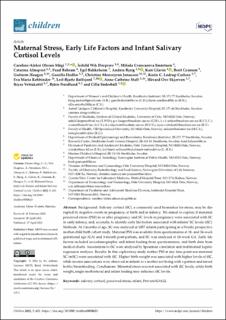| dc.contributor.author | Mägi, Caroline-Aleksi Olsson | |
| dc.contributor.author | Despriee, Åshild | |
| dc.contributor.author | Småstuen, Milada Cvancarova | |
| dc.contributor.author | Almqvist, Catarina | |
| dc.contributor.author | Bahram, Fuad | |
| dc.contributor.author | Bakkeheim, Egil | |
| dc.contributor.author | Bjerg, Anders | |
| dc.contributor.author | Glavin, Kari | |
| dc.contributor.author | Granum, Berit | |
| dc.contributor.author | Haugen, Guttorm Nils | |
| dc.contributor.author | Hedlin, Gunilla | |
| dc.contributor.author | Jonassen, Christine M | |
| dc.contributor.author | Carlsen, Karin Cecilie Lødrup | |
| dc.contributor.author | Rehbinder, Eva Maria | |
| dc.contributor.author | Rolfsjord, Leif Bjarte | |
| dc.contributor.author | Staff, Anne Cathrine | |
| dc.contributor.author | Skjerven, Håvard Ove | |
| dc.contributor.author | Vettukattil, Riyas | |
| dc.contributor.author | Nordlund, Björn | |
| dc.contributor.author | Söderhäll, Cilla | |
| dc.date.accessioned | 2022-06-28T12:19:57Z | |
| dc.date.available | 2022-06-28T12:19:57Z | |
| dc.date.created | 2022-06-27T13:49:21Z | |
| dc.date.issued | 2022 | |
| dc.identifier.citation | Children (Basel). 2022, 9 (5), 1-12. | en_US |
| dc.identifier.issn | 2227-9067 | |
| dc.identifier.uri | https://hdl.handle.net/11250/3001333 | |
| dc.description | This article is an open access article distributed under the terms and conditions of the Creative Commons Attribution (CC BY) license (https:// creativecommons.org/licenses/by/ 4.0/). | en_US |
| dc.description.abstract | Background: Salivary cortisol (SC), a commonly used biomarker for stress, may be disrupted by negative events in pregnancy, at birth and in infancy. We aimed to explore if maternal perceived stress (PSS) in or after pregnancy and SC levels in pregnancy were associated with SC in early infancy, and, secondly, to identify early life factors associated with infants’ SC levels (iSC).
Methods: At 3 months of age, SC was analyzed in 1057 infants participating in a Nordic prospective mother-child birth cohort study. Maternal PSS was available from questionnaires at 18- and 34-week gestational age (GA) and 3-month post-partum, and SC was analyzed at 18-week GA. Early life factors included sociodemographic and infant feeding from questionnaires, and birth data from medical charts. Associations to iSC were analyzed by Spearman correlation and multinomial logistic regression analyses.
Results: In this exploratory study neither PSS at any time point nor maternal SC (mSC) were associated with iSC. Higher birth weight was associated with higher levels of iSC, while inverse associations were observed in infants to a mother not living with a partner and mixed bottle/breastfeeding.
Conclusions: Maternal stress was not associated with iSC levels, while birth weight, single motherhood and infant feeding may influence iSC levels. | en_US |
| dc.language.iso | eng | en_US |
| dc.publisher | MDPI | en_US |
| dc.rights | Navngivelse 4.0 Internasjonal | * |
| dc.rights.uri | http://creativecommons.org/licenses/by/4.0/deed.no | * |
| dc.subject | PreventADALL | en_US |
| dc.subject | infant | en_US |
| dc.subject | perceived stress | en_US |
| dc.subject | salivary cortisol | en_US |
| dc.title | Maternal stress, early life factors and infant salivary cortisol levels | en_US |
| dc.type | Peer reviewed | en_US |
| dc.type | Journal article | en_US |
| dc.description.version | publishedVersion | en_US |
| dc.rights.holder | © 2022 by the authors. Licensee MDPI, Basel, Switzerland. | en_US |
| dc.source.pagenumber | 1-12 | en_US |
| dc.source.volume | 9 | en_US |
| dc.source.journal | Children (Basel) | en_US |
| dc.source.issue | 5 | en_US |
| dc.identifier.doi | 10.3390/children9050623 | |
| dc.identifier.cristin | 2035441 | |
| dc.source.articlenumber | 623 | en_US |
| cristin.ispublished | true | |
| cristin.fulltext | original | |
| cristin.qualitycode | 1 | |

